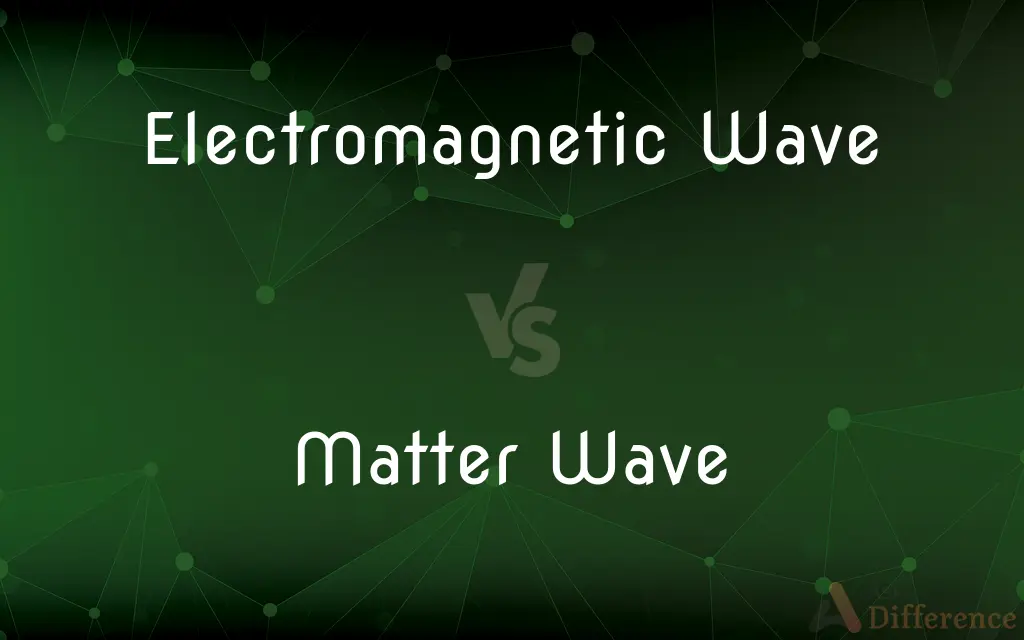Electromagnetic Wave vs. Matter Wave — What's the Difference?
By Tayyaba Rehman — Published on January 11, 2024
Electromagnetic waves are oscillations of electric and magnetic fields, traveling through space, while matter waves are quantum phenomena representing the wave-like behavior of particles.

Difference Between Electromagnetic Wave and Matter Wave
Table of Contents
ADVERTISEMENT
Key Differences
Fundamental Nature: Electromagnetic (EM) waves are composed of oscillating electric and magnetic fields that travel through space at the speed of light. They include visible light, radio waves, and X-rays. Matter waves, conceptualized by Louis de Broglie, represent particles like electrons and atoms exhibiting wave-like properties, a core concept in quantum mechanics.
Transmission Medium: EM waves can travel through a vacuum or material medium, conveying energy and momentum without requiring a physical medium. In contrast, matter waves don't actually travel through space but are mathematical functions describing the probabilities of a particle's position and momentum in quantum mechanics.
Wave Characteristics: EM waves have characteristics like wavelength, frequency, and speed, which determine their place in the electromagnetic spectrum. Matter waves, characterized by the de Broglie wavelength, depend on the momentum of the particle, with shorter wavelengths for more massive particles.
Applications and Implications: EM waves are integral to technologies like radio, TV, and cell phones, and in medical imaging technologies like X-rays. Matter waves are fundamental to understanding atomic and subatomic systems, crucial for technologies like electron microscopy and quantum computing.
Physical Interpretation: EM waves can be directly detected and measured, reflecting the classical understanding of waves. Matter waves are a manifestation of quantum behavior, interpreted through probability distributions, not directly observable in the traditional sense.
ADVERTISEMENT
Comparison Chart
Composition
Oscillating electric and magnetic fields.
Wave-like properties of particles.
Medium of Travel
Can travel through vacuum or material.
Describes probability distributions in space.
Key Characteristics
Wavelength, frequency, speed.
De Broglie wavelength, dependent on particle momentum.
Applications
Communication, medical imaging, etc.
Quantum mechanics, electron microscopy.
Physical Interpretation
Directly measurable and observable.
Interpreted through quantum probabilities.
Compare with Definitions
Electromagnetic Wave
Electromagnetic waves include a spectrum from radio waves to gamma rays.
Ultraviolet light is an electromagnetic wave harmful to human skin.
Matter Wave
Matter waves describe the probability of finding a particle in a particular location.
Electron orbitals in atoms are described by matter waves.
Electromagnetic Wave
Electromagnetic waves travel at the speed of light in a vacuum.
Visible light from the sun reaches Earth as electromagnetic waves.
Matter Wave
Matter waves associate a wavelength to particles, dependent on their momentum.
In a double-slit experiment, matter waves of photons create an interference pattern.
Electromagnetic Wave
Electromagnetic waves can propagate without a medium.
Satellite communications rely on electromagnetic waves traveling through space.
Matter Wave
Matter waves are central to the theory of quantum mechanics.
Quantum tunneling is explained by the wave properties of particles.
Electromagnetic Wave
Electromagnetic waves are used in various technologies, from radios to X-rays.
X-ray machines use electromagnetic waves to image internal body structures.
Matter Wave
Matter waves challenge the classical distinction between particles and waves.
The concept of matter waves is crucial in understanding the behavior of subatomic particles in accelerators.
Electromagnetic Wave
An electromagnetic wave is a wave of oscillating electric and magnetic fields.
Radio signals are electromagnetic waves that transmit audio and data.
Matter Wave
Matter waves are the quantum description of particles exhibiting wave properties.
The wave nature of electrons is demonstrated in electron diffraction experiments.
Common Curiosities
Are matter waves visible?
No, they are not visible and are interpreted through probabilities.
What are electromagnetic waves?
Oscillations of electric and magnetic fields traveling through space.
Can electromagnetic waves travel in a vacuum?
Yes, they can travel through a vacuum.
Are matter waves used in technology?
Yes, in applications like electron microscopy and quantum computing.
What is an example of an electromagnetic wave?
Visible light and radio waves are examples.
What defines a matter wave?
Quantum phenomena showing the wave-like behavior of particles.
How do matter waves relate to quantum mechanics?
They are a fundamental concept in explaining quantum behavior.
Can matter waves be observed in everyday life?
Their effects are observable, but they themselves are not directly seen in everyday life.
Do electromagnetic waves require a medium to travel?
No, they do not require a medium.
What is the de Broglie wavelength in matter waves?
A wavelength associated with particles, dependent on their momentum.
Are all electromagnetic waves visible?
No, only a small portion of the spectrum is visible light.
Do matter waves have a frequency like electromagnetic waves?
They have a wavelength, but their interpretation is different from traditional wave frequency.
How are electromagnetic waves detected?
They can be detected using various instruments like antennas and sensors.
What’s the speed of electromagnetic waves in a vacuum?
They travel at the speed of light, approximately 299,792 km/s.
Do matter waves imply particles are waves?
They suggest particles exhibit both particle-like and wave-like properties.
Share Your Discovery

Previous Comparison
OpenDNS vs. Cloudflare
Next Comparison
Error in Java vs. Exception in JavaAuthor Spotlight
Written by
Tayyaba RehmanTayyaba Rehman is a distinguished writer, currently serving as a primary contributor to askdifference.com. As a researcher in semantics and etymology, Tayyaba's passion for the complexity of languages and their distinctions has found a perfect home on the platform. Tayyaba delves into the intricacies of language, distinguishing between commonly confused words and phrases, thereby providing clarity for readers worldwide.













































